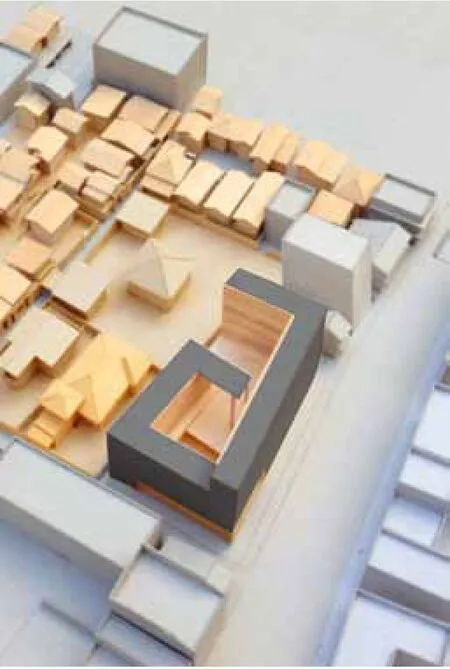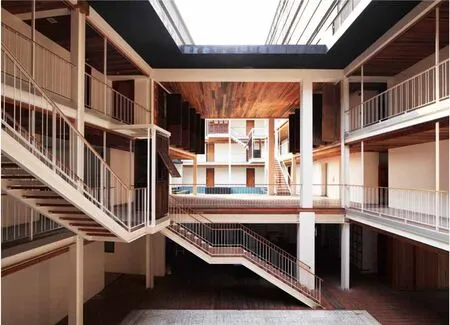南达遗址酒店,曼谷,泰国
2014-02-20建筑设计CHAT建筑师事务所瓦鲁德沙马叻巴
建筑设计:CHAT建筑师事务所,瓦鲁德·沙马叻巴
南达遗址酒店,曼谷,泰国
建筑设计:CHAT建筑师事务所,瓦鲁德·沙马叻巴

1 场地模型,可看出酒店建筑位于现代城市(灰色部分)与老的棚户区(木制部分)的交界处/Site model, showing the building as a threshold between the modern city (in grey) and the old shantytown (in wood)
南达遗址酒店坐落在曼谷新城与一个历史老棚户区的交界处,在新旧世界间的夹缝地带。酒店前面是一条快速干道,通往跨越湄南河的拉玛8号桥,酒店背后就是百年老城区布里那裕·春冲(Purinayok Chumchon)。建筑的前身是始建于1920年的传统欧式柚木建筑,重建后被改造成充满现代气息、环境宜人的特色酒店。
客房外墙覆盖混凝土外壳,像深色的广告牌一样标示着酒店的存在,同时,它为位于建筑中央的露天“私家”庭院提供了一个保护区。标志性的沿街立面带有明显的水平“加速”线条,与现代城市的大尺度、快节奏相呼应(实际上,它们是有着功能性的滴水沿槽)。使用水平线条的最初目的是为了在表皮上刻印名字的时候标注出印刷线。实际上建筑立面真的成了现代大道与老城小巷交汇处的一个功能标志或者广告牌。然而,一旦转过街角来到侧巷,你会发现建筑的体量降低成4层,与小巷内沿街店铺的尺度相匹配。在这里,水平线条变成竖向的建筑缘线,模仿沿街店铺凸窗的造型。就像这样,即便是一条再简单不过的混凝土边缘线条的细节处理也可以成为与城市环境相呼应的设计工具。这些线条与人行道上方满布的电线、电话线也达成某种和谐。这是建筑设计中特意采用的调和元素,一句话,“如果你不能避免它们,那么就试着融入它们吧”。在面向老城区的一侧建筑部分只有2层高,在内院中就可以看到老城的景象。
与外立面的现代风格相反,隐蔽的建筑内庭设计则颇为复古。其精致纤细的白色钢构架,取自酒店主人家老公馆遗存下来的已有百年历史的旧柚木,都被设计所采纳并赋予了新的意义。从老建筑拆卸下来的门、木窗户、地板、通风嵌板、木楼梯和扶手、回收再利用的中葡风格的陶瓷铺砖、老照片、一个老茶馆保存下来的木制桌椅等老物件被重新组合在一起,共同营造出一种复古的环境氛围。从街边的小入口进入其中,就来到了一个奇妙的新旧交替的世界。
内庭这种即兴拼凑的设计是学习棚户区的经验——那里的人们用各种回收材料建造家园。纯净的白色钢制构件将各种老旧的木制品框固起来,使它们像博物馆中的一件艺术品一样被展示。这样设计的目的不是试图重现怀旧的场景,而是客观展示这些历史木制品的真实状态——在这里,现代的建筑元素钢和混凝土就显然是格格不入、不合时宜的了。□(覃莺 译)
The Nanda Heritage Hotel sits on a site between the old and the new world, a threshold between Bangkok's new city and an old historic shanty town. With a high-speed on ramp to Rama 8 Bridge crossing the Chao Phraya River in front and a 100-year-old Purinayok Chumchon (community) in back, the heritage of its ancestor, a European style teak house built in 1920, is reworked as a unique hotel with a contemporary modern design and a charming surrounding atmosphere.
The dark billboard-like concrete outer shell is filled with guest rooms. It acts as a protective buffer zone to the central open air "secret" courtyard in the middle of the building. The monumental street front elevation, with its horizontal "speed" lines (actually, they are functional drip edges), responds to the large scale and fast pace of the modern world. The initial intent of the horizontal lines was to use them as typographical lines for names to be stenciled onto the facade. The elevation becomes a functional sign or billboard for the area, a meeting place of modern avenues and historic alleys. Once the mass of the hotel turns the corner into the side alley, it dips down to a four-storey height to match the scale of the shophouses along the smaller side street. Here, the horizontal speed lines turn 90 degrees to become vertical "Koohah" (building) lines that mimic the shophouse bay. Thus, even a simple concrete edge detail can become a responsive tool at the urban level. These lines also speak to the tangle of electrical and telephone lines strewn above the sidewalk. The blend of elements follows the "if you can’t beat them, join them" philosophy. The building drops another two storeys to frame the view of the Chumchon from the courtyard.
The hotel's hidden courtyard, unlike it's zippy exterior, is inspired by the past. Its delicate frame of thin white steel members and old historic wood--from the remains of the owner's family's 100-yearold teak wood mansion--is adapted to produce new meaning. Dismantled doors, wood windows, floorboards, ventilation panels, wood staircase and handrails, recycled Sino-Portuguese paving ceramic tiles, old photos, wooden chairs and tables saved from an old teahouse are all recombined to create a vintage atmosphere. It is a mysterious eclectic space of the old and new accessed through a small portal from the street.
The inner court improvises its design from lessons learned in the shantytown where people constructed their homes from scavenged building materials. The clean white steel members frame each individual antique wooden element like a museum artifact. The attempt is not to create a nostalgic environment, but rather to present the historic wooden elements as they truly are-out-of-place and out-of-time amongst the modern elements of steel and concrete.□

2 沿街立面全景/Overall view of the street elevation

3 首层平面/Floor 0 plan

4 3、4层平面/Floor 2&3 plans

5 从入口庭院望向抬起的泳池内院/View from the entry court to the elevated pool court
评论
韩林飞:南达遗址酒店坐落在泰国曼谷的新城与旧城之间,地处一条高速公路匝道口,后面是一个100多年延续着当地历史文化的老社区。在这样一个特殊的位置,CHAT选择用黑色外壳围合出了一个封闭的内庭院的形式设计旅店。从外面的车行道看去,纯黑色的外壳确实醒目,并且极具现代感,但鸟瞰整个区域,不难发现其与周边历史建筑格格不入。相反,内部的庭院利用外连廊使得空间变得更加灵活,大面积地使用当地常用的建筑材料——木材,并且重新利用回收的旧窗户、旧百叶,这一切使得内庭院设计变得即兴、有趣。小院与整个建筑外面包裹的黑色外壳也形成强烈的对比,使这个藏身于新、旧城市之间的旅馆建筑诙谐、幽默。
王彦:一座矛盾交织的建筑。
白色轻盈的下部承托着黑色坚实的上部;沉稳封闭的外墙抵抗住城市的喧嚣,守护安静隐秘的内院;而有着上百年历史的木门,恰到好处地嵌入现代钢结构环廊,呈现出新老材料交织的独特意境,耐人寻味。窗台滴水板水平展开,形成具有张力感的建筑立面,这无疑让酒店在场地环境中脱颖而出。容易积聚热量的黑色是否适合当地气候姑且不论,那种冷酷的气势却颇让人感到有些紧张。虽然沿街底层的木色温暖亲切,却丝毫没有准备对街道上的路人开放,不禁唏嘘。
Comments
HAN Linfei: The Nanda Heritage Hotel is located between the old and new cities of Bangkok. The building is positioned between a highway ramp and an old residential community, a locus of community history and culture for more than a hundred years. The black facades of the building wrap a light courtyard at the center of the scheme. From the lanes surrounding the hotel, the pure black color is impressive and modern. But in the context of the neighborhood, it seems incompatible with the historic fabric of the surrounding buildings. The inner courtyard incorporates a lot of local wood as well as reclaimed old windows and shutters that are more in keeping with the traditional building motifs of the neighborhood.The space is flexible and attractive. The strong contrast between the black exterior of the building and the gentler natural finishing of this inner core gives the building a witty and humorous tone.
WANG Yan: A Complicated Construction.
The solid black volume is supported by a light-coloured graceful podium. The calm enclosing wall of the hotel keeps out the hustle and bustle of the modern city while it embraces a quiet and peaceful inner courtyard. Two-hundred year old wooden doors punctuate the steel structure of the building's corridors. This mixing of new and old construction materials is truly interesting. The hotel's exterior window sills run on beyond the openings they serve. They morph into the strong horizontal datum of the facade. The hotel stands out in its site and environment. The black color of the building too easily absorbs the heat of this place but also establishes an imposing tone that makes people feel a little nervous. Although the wood material used in places at street level is warm and kind, it is used in a way that is opaque and does not open up the experience of the hotel interior to passersby in the street.
项目信息/Credits and Data
客户/Clients: Sarnanda and Medhavin Lekhyananda
室内设计/Interior Designers: 公共区域/Public Areas:CHAT建筑师事务所(与瓦鲁德·沙马叻巴合作)/CHAT Architects (in collaboration with Varoot Samalapa);客房/ Guest Rooms: 客户/Owner
场地面积/Site Area: 1266m2
建筑面积/Floor Area: 4000m2
设计时间/Design Period: 2009
摄影/Photos: Ketsiree Wongwan
Nanda Heritage Hotel, Bangkok, Thailand, 2014
Architects: CHAT Architects, Varoot Samalapa

6 私密内庭实景/View within the secret courtyard
